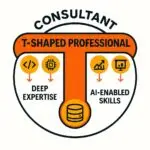Introduction
When I start a new assignment as an interim manager, a learning strategist, or a change consultant, I don’t begin with processes, org charts, or strategy documents. I begin with questions. Not just any questions, but the kind that reveals how people actually work, learn, and make decisions. No matter how polished the onboarding or how clear the formal structures appear, the reality of an organization lives in its culture, in the unspoken rules, and in the daily patterns people have learned to navigate.
What do I do?
Here are the three questions I always ask, and why they matter.
1. How does learning really happen here?
It’s easy to point to an LMS, a set of onboarding modules, or a leadership program. But real learning doesn’t just happen in training sessions. It shows how people deal with mistakes, change, and uncertainty. Do people feel safe to say: “I don’t know”? Are lessons from the past shared and applied, or brushed aside? Do teams reflect regularly, or only when something goes wrong? This question tells me a lot about psychological safety in the organization, and whether there is room to grow, not just professionally, but as a collective.
2. Who decides what matters?
Forget the org chart for a moment. Influence in organizations is rarely linear. I try to understand who people turn to when they’re unsure, who frames discussions in meetings, and who sets the unspoken boundaries.
Sometimes it’s the formal leader. Often, it’s someone with experience, seniority, or just a strong network. Understanding these informal lines of influence helps me know where to engage, where resistance might live, and where true leverage for change exists.
3. Where is the friction?
I look for hesitation, silence, or irony in conversations. Where people lower their voice, shrug their shoulders, or switch topics, those are signs that something important is hiding in plain sight. It could be tension between departments, outdated systems, unclear roles, or conflicting KPIs. But the friction is never random. It’s a signal.
And as a change leader, I need to know:
– What is not working, but no one wants to talk about?
– Where do people feel stuck, unheard, or stretched too thin?
– What are the “unsaid things” everyone quietly works around?
These three questions don’t solve anything by themselves. But they open the door to honest conversations, the kind you need if you want to create movement.
For whom is this relevant?
And they’re not just for interim professionals. Whether you’re a team lead, an HR business partner, or a transformation lead: asking better questions helps you see more clearly, faster. What do you ask yourself when you step into a new organization or role? I’d love to hear how others approach this.





